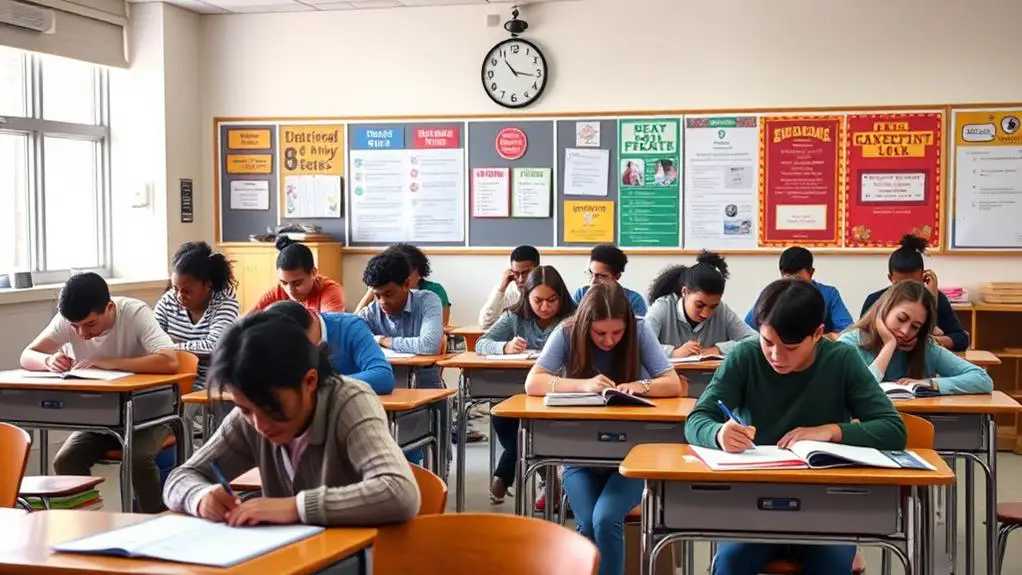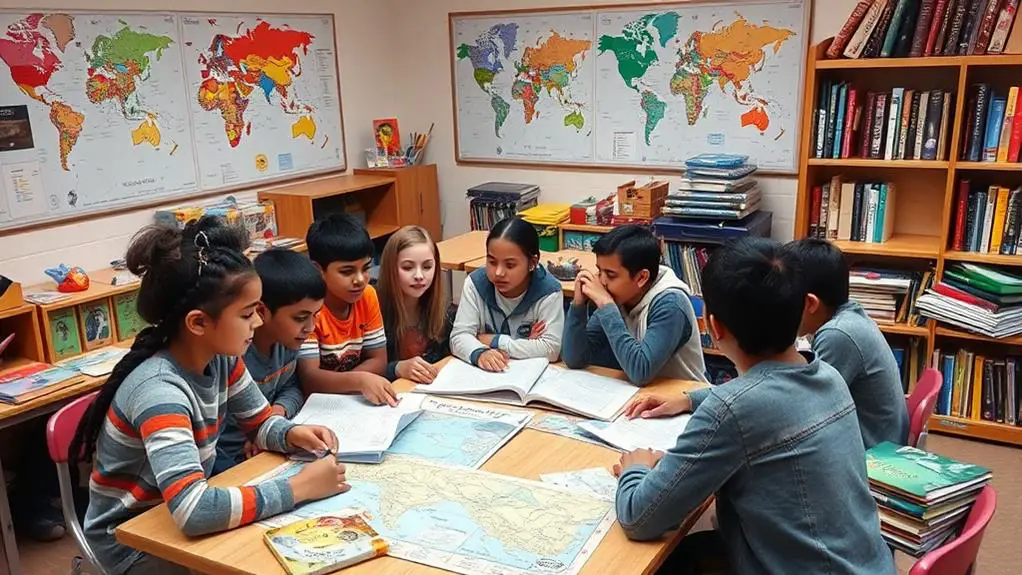Reflecting on Maya Angelou‘s wisdom, ‘I’ve learned that people will forget what you said, people will forget what you did, but people will never forget how you made them feel.’ Positivity in the classroom is a powerful force that molds the community, nurturing a sense of unity that can deeply impact students’ academic and social development.
The influence of a positive atmosphere extends far beyond the confines of the classroom, shaping students’ mindsets, actions, and connections in ways that are truly transformative.
Creating an environment filled with optimism and encouragement sets the stage for students to thrive and grow. When teachers infuse their interactions with positivity, students feel supported, valued, and motivated to reach their full potential. This sense of belonging and positivity can lead to increased engagement, improved relationships, and a stronger sense of community within the classroom.
By fostering a culture of positivity, teachers can inspire students to approach challenges with resilience and optimism. When faced with difficulties, students who have experienced a positive classroom environment are more likely to persevere, learn from setbacks, and develop valuable life skills such as empathy, teamwork, and problem-solving.
Ultimately, the impact of positivity in the classroom goes beyond academic success; it equips students with the tools they need to navigate the complexities of the world with confidence and compassion.
Strengthening Classroom Community Through Positivity

Fostering a positive classroom community is vital for student success.
Kindness cultivates connections, and uplifting words can have a profound impact on students.
Recognizing small accomplishments, embracing diversity, and promoting empathy are key elements in creating an environment where everyone feels supported and appreciated.
Let’s envision a classroom where positivity thrives, and students are empowered to learn and grow together.
Kindness Breeds Connection
By fostering a culture of kindness in the classroom, students naturally gravitate towards building stronger connections with their peers and teachers. Engaging in random acts of kindness, like complimenting a classmate or helping a teacher with a task, can spark a chain reaction of positivity within the classroom. Encouraging selfless gestures, such as sharing notes or supporting a struggling peer, not only strengthens relationships but also cultivates a sense of unity among students.
Implementing a kindness challenge where students are assigned to perform acts of kindness for others can further enhance these connections. Empathy-building activities, like role-playing scenarios or sharing personal experiences, can help students empathize with each other’s perspectives and develop mutual respect. As these practices become embedded in the classroom atmosphere, a cycle of positivity emerges, where acts of kindness multiply and deepen the bonds between classmates.
Promoting kindness not only enhances individual well-being but also establishes a welcoming and inclusive classroom environment where everyone feels valued and supported.
Encouraging Words Matter
Encouraging words are crucial for creating a positive classroom environment and strengthening connections between students and teachers. When we uplift others through positive affirmations, compliments, motivational phrases, and feedback, we foster a sense of value and support for everyone involved.
Here’s why these elements are essential for building a strong classroom community:
- Uplifting Messages: Sharing kind and empathetic messages cultivates a culture of support and kindness among students, encouraging them to help each other.
- Positive Affirmations: Providing affirmations boosts students’ self-esteem and confidence, leading to a more optimistic approach to learning and personal growth.
- Inspiring Compliments: Recognizing students’ efforts and accomplishments with inspiring compliments motivates them to continue striving for success.
- Motivational Phrases: Using motivational language instills determination and resilience in students, empowering them to overcome obstacles and achieve their full potential.
Incorporating these elements into classroom interactions can have a profound impact on student morale and engagement, creating a space where everyone feels valued and encouraged to succeed.
Celebrate Small Victories
Regularly commemorating small victories in the classroom helps foster a positive and supportive environment conducive to growth and collaboration. It’s crucial to celebrate progress, share successes, acknowledge achievements, highlight growth, and commend efforts.
Recognizing even the smallest accomplishments establishes a culture of appreciation and motivation that uplifts everyone.
When a student overcomes a challenging concept, finishes a project, or demonstrates kindness towards their peers, it’s essential to celebrate these moments. Whether through verbal praise, a high-five, or a small token of recognition, every acknowledgment contributes to a sense of belonging and encouragement within the classroom.
These celebrations not only boost individual confidence but also strengthen the bonds between classmates. When we collectively rejoice in each other’s victories, we create a supportive community where everyone feels valued and inspired to continue striving for excellence.
Embracing the power of celebrating small wins can lead to a flourishing classroom filled with positivity and unity.
Embrace Diversity in Class
Embracing diversity in class fosters a vibrant and inclusive environment that enriches our classroom community with a wide range of perspectives and experiences. Each student contributes a unique cultural background and set of beliefs, creating a diverse tapestry that enhances our learning environment.
To truly embrace diversity in class, we focus on several key aspects:
- Cultural Respect: We show appreciation and respect for each other’s cultural heritage, fostering a sense of belonging and admiration within the classroom.
- Inclusive Tasks: Engaging in activities that cater to different learning styles and preferences ensures that every student feels valued and included.
- Global Perspectives: Encouraging discussions and projects that explore various global viewpoints expands our understanding of the world and promotes open-mindedness.
- Mutual Appreciation: Building a culture of mutual respect nurtures positive relationships among classmates and creates a safe space for exchanging diverse opinions.
Foster Empathy and Understanding
To strengthen our classroom community positively, nurturing empathy and understanding among students is essential. Including empathy exercises and understanding activities can significantly enhance the bonds within our class.
Through engaging in perspective sharing, we can step into each other’s shoes, fostering both compassion development and connection building simultaneously.
Empathy exercises, such as role-playing scenarios or discussions on real-life situations, can help students grasp diverse viewpoints and emotions. These activities encourage individuals to consider others’ feelings and experiences, promoting empathy in the process.
Understanding activities, like group discussions or collaborative projects, provide opportunities for students to learn from one another. By actively listening and valuing different opinions, we can cultivate a culture of respect and comprehension in our classroom.
Practice Gratitude Daily
Practicing gratitude daily in the classroom creates a positive atmosphere where appreciation and kindness flourish. As an educator, integrating gratitude practices into the daily routine can profoundly impact the classroom community.
Here are four ways to nurture gratitude among students:
- Gratitude Journaling: Encourage students to maintain a gratitude journal where they jot down things they appreciate each day. This habit helps them focus on the bright spots in their lives.
- Daily Affirmations: Kickstart the day with positive affirmations to establish a grateful mindset. Affirmations can enhance confidence and cultivate a sense of thankfulness.
- Mindful Appreciation: Teach students to mindfully acknowledge the little things around them, fostering gratitude for the present moment.
- Positive Reflections: At the end of each day, prompt students to reflect on moments that brought them joy or valuable lessons, promoting a positive outlook.
Create Safe Space
In my classroom, I make it a top priority to establish a safe and supportive environment where students can thrive. Building trust is fundamental to my teaching approach, and I’m dedicated to creating an inclusive space where every student feels valued and respected.
By fostering a culture of support, I aim to cultivate an uplifting atmosphere that nurtures both academic growth and emotional well-being. Positive interactions play a vital role in my classroom, as they help strengthen interpersonal connections among students and foster a sense of belonging.
To ensure a safe space, I promote open communication and mutual respect among students. I listen attentively to their concerns and offer assistance whenever necessary. By demonstrating empathy and understanding, I set a positive example for a classroom where students feel comfortable expressing themselves and taking academic challenges.
Establishing this supportive environment enables students to fully engage in their learning, knowing they’re part of a compassionate community that prioritizes their overall well-being.
Encourage Active Listening
Encouraging active listening within the classroom is crucial for building strong connections and enhancing the overall learning experience. When students actively participate in attentive listening, it establishes a solid groundwork for respectful interactions and meaningful discussions.
Here are four effective strategies to promote active listening in the classroom:
- Lead by Example: Setting a positive precedent by actively listening yourself can inspire students to follow suit.
- Teach Active Listening Techniques: Educate students on methods like paraphrasing and asking clarifying questions to enhance their listening abilities.
- Foster Turn-Taking: Cultivate an environment where everyone has an opportunity to share their thoughts, fostering a culture of attentive listening.
- Offer Positive Reinforcement: Acknowledge and commend instances of active listening, reinforcing this behavior throughout the classroom community.
Support Each Other
Supporting each other in the classroom is essential for creating a positive and unified atmosphere. Peer support helps strengthen relationships and build a sense of community among students.
Offering assistance or a listening ear to our classmates not only demonstrates kindness but also fosters trust and camaraderie. Acknowledging the efforts of our peers through positive reinforcement encourages them to continue growing.
Engaging in empathy circles allows us to gain a deeper understanding of each other’s perspectives, ensuring that everyone feels valued and heard. These interactions form strong bonds that extend beyond the classroom, enhancing our sense of community.
Promote Teamwork and Collaboration
Promoting teamwork and collaboration in the classroom strengthens our connections and nurtures a sense of togetherness among students. Engaging in team-building activities and creating a collaborative atmosphere can significantly enhance the classroom dynamic.
Here are four essential ways to encourage teamwork and collaboration:
- Engage in Team Building: Involve students in activities that necessitate teamwork, like group challenges or problem-solving tasks. These experiences foster a shared sense of achievement and solidarity.
- Assign Group Projects: Tasking students with group projects motivates them to collaborate towards a common objective, enhancing their teamwork and communication skills.
- Encourage Peer Support: Inspire students to assist and encourage each other. Peer support not only enhances learning but also cultivates a supportive and inclusive classroom environment.
- Implement Collaborative Learning: Introduce strategies for collaborative learning where students work together to attain academic success. This method encourages the exchange of knowledge, skills, and experiences among peers.
Incorporating cooperative games and activities into the classroom setting further reinforces the spirit of teamwork and unity among students, creating a positive and nurturing learning environment.
Share Positive Stories
Sharing positive stories in the classroom creates a warm and encouraging atmosphere where students can thrive. These stories, filled with uplifting moments, inspiring acts, and heartwarming gestures, have a profound impact on everyone involved. They serve as beacons of hope, showcasing the best in people and the power of kindness and empathy.
By sharing tales of resilience, compassion, and generosity, we not only spread joy but also reinforce the values of community, support, and understanding within our classroom.
When students hear about the kindness of their peers or teachers, it motivates them to follow suit, fostering a culture of positivity and mutual respect. These anecdotes remind us that even small actions can brighten someone’s day.
Acknowledge Individual Strengths
Acknowledging the unique strengths that each student possesses in the classroom is a powerful way to nurture a sense of belonging and support personal growth. When we take the time to recognize their talents and abilities, we create an environment where every student feels valued and encouraged to strive for excellence. Providing positive affirmations not only boosts their confidence but also instills a sense of pride in their skills, leading to greater engagement and a more positive approach to learning.
It’s important to emphasize to students that everyone has something special to offer, which helps to enrich the classroom community. Celebrating individual differences further reinforces the idea that diversity is a strength, fostering a sense of acceptance and appreciation for each student’s unique qualities. Embracing the strengths of each student not only benefits them personally but also contributes to a cohesive and inclusive classroom where everyone can thrive and be empowered to reach their full potential.
Spread Joy and Positivity
In the midst of the daily challenges in the classroom, infusing joy and positivity can create a warm and uplifting atmosphere that enhances the overall classroom community. Engaging in fun activities, sharing encouraging words, and reflecting on motivational quotes can have a profound impact on the classroom environment. Cultivating a culture of gratitude journaling and establishing a supportive setting can benefit both students and teachers alike.
Let’s incorporate joyful activities like enjoyable group games, innovative art projects, music and dance sessions, and outdoor learning experiences into our routines. Alongside these, let’s share positive affirmations such as ‘I believe in your abilities’, ‘You are making a difference’, ‘Your efforts are appreciated’, and ‘You are capable of great things’.
Conclusion
In nurturing a positive classroom environment, we plant seeds of kindness that bloom into a vibrant garden of connection and support.
Recognizing and celebrating achievements, embracing diversity, and promoting teamwork are key ingredients for cultivating a lively community where every student feels valued and respected.
Let’s continue to spread joy, acknowledge individual talents, and share inspiring stories to create a safe and inclusive space where all learners can thrive.
Together, we can build a classroom community that flourishes like a beautiful garden in full bloom.














